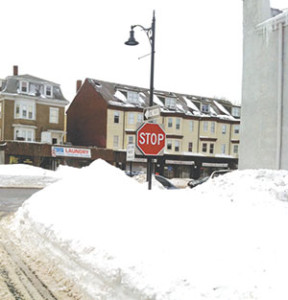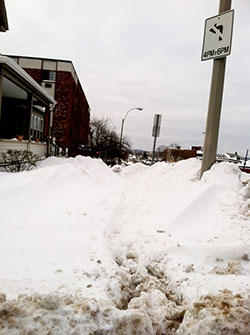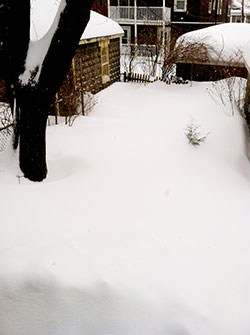
Most of us just wish it would stop, but the snow is expected to keep falling through the rest of the week. It’s smart to stop and consider some of the ways we can best get through it. — Photos by Bobbie Toner
By Jim Clark
As the record-breaking snowfall continues, area residents are contending with unprecedented accumulations of snow and ice. The current levels have far exceeded those seen as far back as the blizzard of 1978 and beyond.
City work crews are operating at optimum capacity while school and transit closures have become commonplace in the face of current conditions.
With the prospect of further snowfall continuing through the week, certain safety measures should be taken into account as we head into the days ahead.
The City of Somerville has issued a series of advisories aimed at helping residents to cope with the snow emergency in a safe and secure fashion. The winter storm safety tips include:
- Clearing exterior exhaust vents, including vehicle tail pipes, to prevent carbon monoxide poisoning.
- Safely clearing snow and ice buildups on roofs.
- Being careful when shoveling snow. Over-exertion can lead to extreme injury or accidents. Residents are encouraged to find out how to get shoveling assistance.
- Driving slowly and being aware of children playing the streets or on/around snow piles.
Additionally, residents are urged to:
- Stock emergency kits with supplies to last three to five days, including a first aid kit, essential medications, non-perishable foods, a manual can opener, water, flashlights and extra batteries, baby-care or pet supplies, blankets and sleeping bags.
- Fully charge portable electronic devices, and conserve battery use for emergencies in case of power outages.
- Check outside fuel exhaust vents, making sure that they are not obstructed by snow or ice.
- Ensure that smoke and carbon monoxide detectors have batteries and are working.
- Consider having extra cash on hand.
- Identify fire hydrants before they are covered in snow so you can help dig them out later.
During storms it is important to:
- Stay indoors unless absolutely necessary, and remain off the roads (Governor Baker has declared a travel ban).
- Never use cooking equipment intended for outside use indoors as a heat source or cooking device.
- Check in on friends, family, and neighbors, particularly elderly residents and/or persons with disabilities.
- If you must let your pet(s) outdoors, supervise them and do not allow them to remain outside.
- REMEMBER: salt and other ice-removal products can harm your pet’s paws. Wipe their paws after returning indoors.
In the event of major and/or sustained power outages, the city will make plans to open a shelter within the city. Updates will be sent via the city’s mass notification system, police bulletins, and, if necessary, door-to-door visits.
After a storm it is important to:
- Help dig out fire hydrants and storm drains in your neighborhood.
- Report downed wires to 911 and do not touch them.
- Be aware of children playing in the streets, climbing on or running out from behind large snow piles.
- Safely reduce the amount of snow and ice on roofs.
- Check on elderly neighbors or those with disabilities, assist with shoveling or other necessary precautions.
The city has also issued warnings concerning carbon monoxide contamination risks associated with the winter storm conditions. These include:
Automobiles, heaters, cooking appliances, and other everyday items produce carbon monoxide when they run. This gas is normally vented out of buildings and cars long before it poses any health risk, but this cannot happen if exterior vents are blocked by snow, ice, or debris. Carbon monoxide is deadly in high quantities. Because the gas cannot be seen, smelled, or tasted, it is extremely important that all exterior home heating vents and vehicle tail pipes be cleared completely, and that smoke and carbon monoxide detectors are tested to ensure they have batteries and are working.
Symptoms of carbon monoxide poisoning may include: dull headache, weakness, dizziness, nausea, vomiting, shortness of breath, confusion, blurred vision, and loss of consciousness.
If you notice signs of carbon monoxide poisoning or your detector goes off, get into fresh air immediately and dial 911.
By following these tips and paying attention to hazardous conditions that may arise, we can all get through the current situation safely and effectively.

















Reader Comments